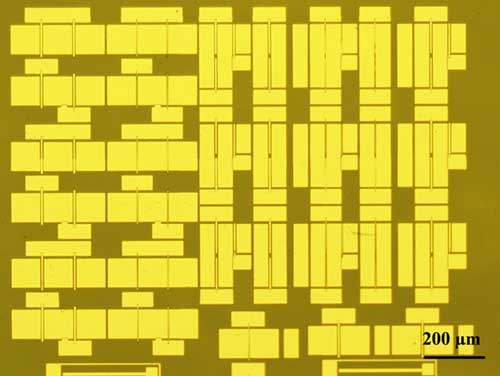| Posted: Aug 02, 2017 |
Development of logic circuits with diamond-based transistors
(Nanowerk News) A NIMS research group led by Jiangwei Liu (independent scientist, Research Center for Functional Materials) and Yasuo Koide (coordinating director in the Research Network and Facility Services Division) has succeeded for the first time in the world in developing logic circuits equipped with diamond-based MOSFETs (metal-oxide-semiconductor field-effect-transistors) at two different operation modes (IEEE Electron Device Letters, "Logic Circuits With Hydrogenated Diamond Field-Effect Transistors").
|
|
This achievement is a first step toward the development of diamond integrated circuits operational under extreme environments.
|
 |
| Micrograph of a fabricated logic circuit equipped with diamond-based transistors. (Image: NIMS)
|
|
Diamond has high carrier mobility, a high breakdown electric field and high thermal conductivity. Therefore, it is a promising material to be used in the development of current switches and integrated circuits that are required to operate stably at high-temperature, high-frequency, and high-power.
|
|
However, it had been difficult to enable diamond-based MOSFETs to control the polarity of the threshold voltage, and to fabricate MOSFETs of two different modes—a depletion mode (D mode) and an enhancement mode (E mode)—on the same substrate. The research group has successfully developed a logic circuit equipped with both D- and E-mode diamond MOSFETs after making a breakthrough by fabricating them on the same substrate using a threshold control technique developed by the group.
|
|
The research group identified the electronic structure in the interface between various oxides and hydrogenated diamond using photoelectron spectroscopy in 2012.
|
|
The research group then succeeded in developing a diamond MOS (metal-oxide-semiconductor) capacitor with very low leakage current density and an E-mode hydrogenated diamond-based MOSFET in 2013 after going through many difficulties.
|
|
The group then prototyped logic circuits by combining diamond-based MOSFETs with load resistors in 2014.
|
|
Finally, the group developed techniques to control D- and E-mode characteristics of diamond-based MOSFETs and identified the control mechanism in 2015.
|
|
A series of these R&D accomplishments were introduced in AIP publishing news by the American Institute of Physics. These previous efforts led to the success made in this research project.
|
|
The logic circuits with diamond-based transistors are promising devices to be used in the development of digital integrated circuits that are required to stably operate under extreme environments such as high-temperature as well as exposure to radiation and cosmic rays.
|
|
This research was conducted in conjunction with the following projects: Leading Initiative for Excellent Young Researchers (Jiangwei Liu, representative), under the sponsorship of the MEXT Human Resource Development Program for Science and Technology; “Development of new functional diamond electronic devices using a large amount of polarized charges” (Yasuo Koide, principal investigator), under the category of Grant-in-Aid for Scientific Research (A) sponsored by the MEXT Grants-in-Aid for Scientific Research; and “Fabrication of high-current output fin-type diamond field-effect transistors” (Jiangwei Liu, principal investigator), under the category of Grant-in-Aid for Young Scientists (B) sponsored by the MEXT Grants-in-Aid for Scientific Research. Device fabrication was supported by the NIMS Nanofabrication Platform, established under the MEXT Nanotechnology Platform Japan program.
|

